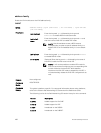role [active |
passive]
Enter the role that the local system assumes:
• Active — The active system initiates the BFD session.
Both systems can be active for the same session.
• Passive — The passive system does not initiate a
session. It only responds to a request for session
initialization from the active system.
The default is Active.
Defaults See Parameters
Command
Modes
INTERFACE
Command
History
This guide is platform-specific. For command information about other platforms,
refer to the relevant Dell Networking OS Command Line Reference Guide.
The following is a list of the Dell Networking OS version history for this command.
Version Description
9.0.0.0 Introduced on Z9000.
8.3.19.0 Introduced on the S4820T.
8.3.12.0 Introduced on S4810.
8.2.1.0 Introduced on the E-Series ExaScale.
7.5.1.0 Introduced on the E-Series.
Usage
Information
This command provides the flexibility to fine-tune the timer values based on
individual interface needs when ISIS BFD is configured in CONFIGURATION mode.
Any timer values specified with this command overrides timers set using the bfd
all-neighbors command. Using the no form of this command does not disable
BFD if BFD is configured in CONFIGURATION mode.
To disable BFD on a specific interface while BFD is configured in CONFIGURATION
mode, use the keyword disable.
neighbor bfd
Explicitly enable a BFD session with a BGP neighbor or a BGP peer group.
S4820T
Syntax
neighbor {ip-address | peer-group-name} bfd
Bidirectional Forwarding Detection (BFD)
395


















